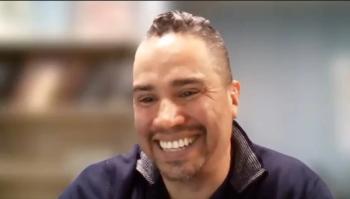
Oncology NEWS International
- Oncology NEWS International Vol 17 No 5
- Volume 17
- Issue 5
No overall survival benefit for dose-intense regimen in SCLC
Boosting the intensity of ICE chemotherapy still can’t overcome the inherent chemoresistance of small-cell lung cancer, according to study results from the European Group for Blood and Marrow Transplantation.
Boosting the intensity of ICE chemotherapy still can’t overcome the inherent chemoresistance of small-cell lung cancer, according to study results from the European Group for Blood and Marrow Transplantation. The lackluster results from this phase III trial should put the “final nail in the coffin” of high-dose cytotoxic chemotherapy in SCLC, according to Paul Bunn, Jr., MD, of the University of Colorado Cancer Center in Aurora.
Serge Leyvraz, MD, and colleagues enrolled 140 previously untreated patients with limited or extensive SCLC (no more than two metastatic sites) to receive a standard-dose regimen of ifosfamide, carboplatin, and etoposide (Std-ICE) (six 28-day cycles) or high-dose ICE (High-ICE) (three 28-day cycles) (J Natl Cancer Inst 100:533-541, 2008).
In the High-ICE group, peripheral blood progenitor cells that had been collected pretreatment were reinfused 48 hours after chemotherapy. Filgrastim was given subcutaneously for 14 days.
The median relative dose intensification for the High-ICE patients, compared to the Std-ICE patients, was 293%.
There were no significant differences in 3-year overall survival rates (18% for High-ICE and 19% for Std-ICE); median progression-free survival (12.2 months vs 8.8 months); or overall response rates (78% vs 68%).
In the High-ICE group, 100% of patients had grade 4 leukopenia and thrombocytopenia; 88% had grade 3-4 anemia. In the Std-ICE arm, 70% had grade 3-4 neutropenia, and 25% had grade 3-4 thrombocytopenia and anemia.
“The approach explored in the present trial succeeded in raising the peak dose, total dose, and dose intensity of ICE by threefold but has clearly been ineffective and highly toxic,” the authors wrote. “As a result, this strategy should be abandoned.”
In an accompanying editorial, Dr. Bunn wrote, “The data from this study combined with those from other studies should put an end to the era of high-dose ‘desperate’ therapies.” Both Dr. Bunn and Dr. Leyvraz’s group urged that other potential therapies be explored.
Articles in this issue
over 17 years ago
Immunotherapy agent promising in NSCLCover 17 years ago
NCCN greenlights nilotinib for imatinib-resistant CML patientsover 17 years ago
Make a note of new smoking cessation codesover 17 years ago
Relistor for treating OICover 17 years ago
Experts argue against need for phase III proton Rx trialsover 17 years ago
Spotlight on Cancer Centersover 17 years ago
Novel peptide vaccine promising in myeloid leukemiaover 17 years ago
Intensive imatinib/chemo ups EFS in pediatric Ph+ ALLover 17 years ago
Relapsing DLBCL patients respond to rituximab-based RxNewsletter
Stay up to date on recent advances in the multidisciplinary approach to cancer.

















































































